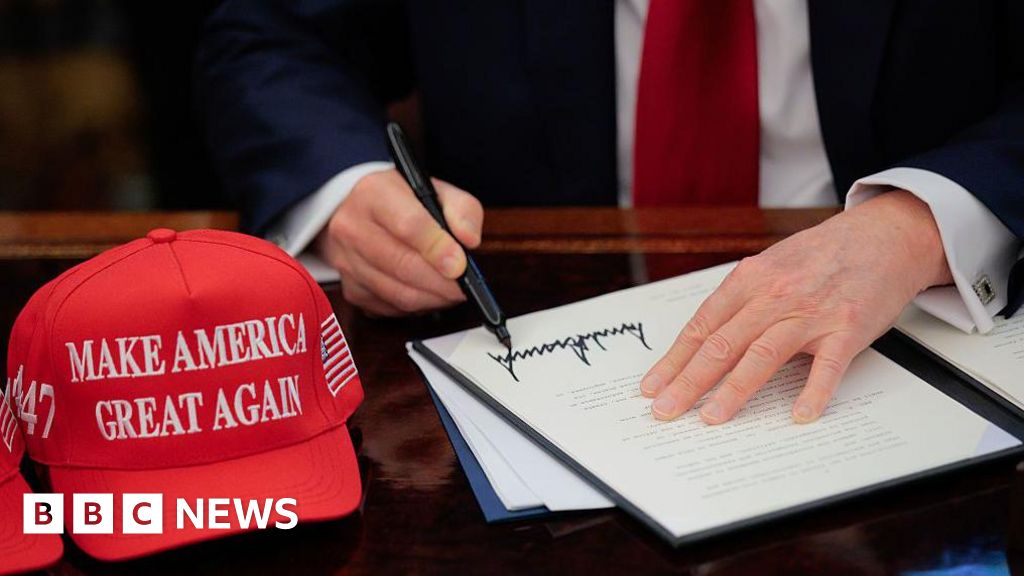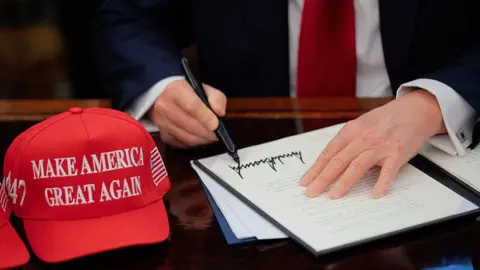 Getty Images
Getty ImagesNew US tariffs covering goods from several key trading partners are due to take effect on 1 August.
Since returning to office in January, President Donald Trump has introduced a series of import taxes, and threatened many more.
He argues that the tariffs boost American manufacturing and protect jobs.
However, his volatile international trade policy has thrown the world economy into chaos, and a number of firms have increased prices for US consumers as a result.
What are tariffs and how do they work?
Tariffs are taxes charged on goods bought from other countries.
Typically, they are a percentage of a product’s value.
A 10% tariff means a $10 product has a $1 tax on top – taking the total cost to the importer $11 (£8.35).
Companies that bring foreign goods into the US have to pay the tax to the government.
They may pass some or all of the extra cost on to customers. Firms may also decide to import fewer goods.
At the end of May, a US trade court ruled that Trump did not have the authority to impose some of the tariffs he has announced, because he did so under national emergency powers.
But the following day, an appeals court said the relevant taxes could stay in place while the case continued.
Why is Trump using tariffs?
Trump says tariffs will encourage US consumers to buy more American-made goods, increase the amount of tax raised and boost investment.
He wants to reduce the gap between the value of goods the US buys from other countries and those it sells to them – known as the trade deficit. He argues that America has been taken advantage of by “cheaters”, and “pillaged” by foreigners.
The president has announced different tariffs against specific goods, and imports from individual countries.
Many of these have been subsequently amended, delayed or cancelled altogether.
Critics accuse Trump of making dramatic and sometimes contradictory policy statements as a negotiating tactic to encourage trade partners to agree deals that benefit the US.
Trump has made other demands alongside the tariffs.
Setting out the first tariffs of his current term against China, Mexico and Canada, he said all three countries must do more to stop migrants and illegal drugs reaching the US.
Separately, on 14 July, Trump threatened to introduce significant tariffs against companies trading with Russia, if a deal to end the war in Ukraine was not reached within 50 days.
Which tariffs has the US put in place on specfic goods?
The taxes on goods imported to the US include:
On 8 July, Trump threatened to impose a 200% tariff on pharmaceutical imports but no further details have been confirmed.
Trump has also said the global tariff exemption covering goods valued at $800 or less will end on 29 August.
He had already removed the so-called “de minimis” exemption for products from China and Hong Kong, to restrict American’s purchase of cheap clothes and household items from commerce sites like Shein and Temu.
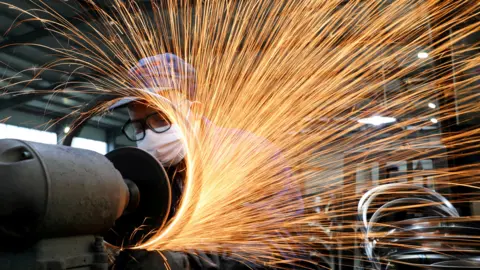 Reuters
ReutersWhich tariffs has the US put in place against individual countries?
Some of the first tariffs targeting China, Canada and Mexico were subsequently amended, increased or postponed.
On 2 April, Trump announced that a “baseline tariff” of 10% would apply to all other imports from all countries.
He said goods from about 60 other trade partners which the White House described as the “worst offenders” – including the EU and China – would face higher rates, as payback for unfair trade policies.
These “reciprocal” tariffs were later postponed for 90 days to allow time to negotiate individual trade deals, and the deadline was then extended until 1 August.
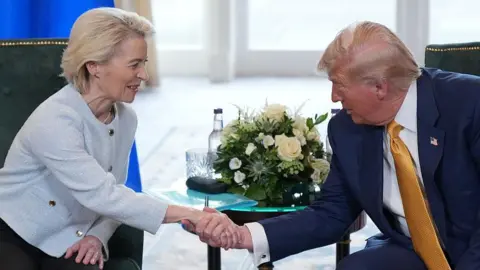 Getty Images
Getty ImagesDays before the 1 August deadline, the US and EU agreed that European goods would face 15% tariffs – including cars. Under the deal – which needs to be approved by all 27 EU members – the trading bloc will charge US firms 0% duty on certain products.
Other tariff rates which will apply from 1 August include:
Unless a separate deal is agreed, a 35% tariff will apply to all Canadian goods on top of existing duties. This excludes products covered by the existing North American free trade agreement (NAFTA) between Canada, the US and Mexico.
Trump has also said he will impose 30% tariffs on all Mexican goods – or a higher rate to match any retaliatory duties introduced on US imports. Again, this does not include products which meet the terms of NAFTA.
US-Chinese trade negotiations are ongoing.
The two countries had raised tariffs on each other’s goods to more than 100% before temporarily lowering rates for a 90-day period. That pause is set to end on 12 August.
What have the UK and US agreed on tariffs?
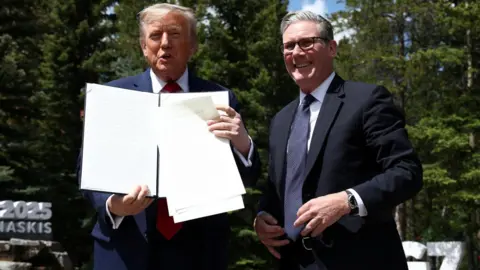 Reuters
ReutersAt 10%, the UK has negotiated the lowest US tariff rate so far.
The UK exported about £58bn of goods to the US in 2024, mainly cars, machinery and pharmaceuticals.
The 10% rate applies to the first 100,000 UK vehicles exported to the US every year, which is roughly the number of cars sold in 2024. Each vehicle above the quota would face the standard 25% car tariff.
The agreement also lets the two countries sell beef to each other – although the government insists there will be no change to the UK’s higher food safety standards.
Some US ethanol will face 0% tariffs, compared to the previous rate of 19%.
The two countries agreed an initial framework in May. Trump announced “the deal was done” at the G7 summit in Canada in June.
However, he did not confirm the expected removal of charges on steel imports from the UK which was outlined in May. Although the UK is the only country which does not have to pay 50% tariffs on steel and aluminium, a 25% tariff remains.
How has the global economy responded to Trump’s tariffs?
Trump’s various announcements have caused volatility on global stock markets, where firms sell shares in their business. However markets have recently been more stable.
Many people are affected by stock market price changes, even if they don’t invest in shares directly, because of the knock-on effect on pensions, jobs and interest rates.
The value of the US dollar, usually considered a safe asset, has also fallen sharply at times.
The International Monetary Fund (IMF) and the influential Organization for Economic Co-operation and Development (OECD) both downgraded their predictions for global economic growth in 2025 as a result of the tariffs.
Both organisations expect the US economy to be badly affected.
The latest figures show the US economy grew at an annual rate of 3% between April and June 2025, after shrinking in the first three months of the year.
The president insists his trade policy is working, but influential voices within his own Republican Party have joined opposition Democrats and foreign leaders in attacking the measures.
Are prices going up for US consumers?
Analysts say tariffs are already feeding into the overall US inflation rate, as businesses pass on some or all of their higher costs.
Prices rose by 2.7% in the year to June, up from 2.4% the previous month reflecting increases in items including clothing, coffee, toys and appliances.
Adidas has confirmed it will raise prices for American customers as a result of the tariffs. Almost half of the company’s products are made in Vietnam and Indonesia which are facing levies of 20% and 19% respectively.
Nike has also said US prices will increase, warning the tariffs could add $1bn (£730m) to its costs.
Barbie maker Mattel also plans to charge more in the US.
Some companies are choosing to import fewer foreign goods, which can make those which are available more expensive.
The costs of goods manufactured in the US using imported components are also expected to rise.
For example, car parts typically cross the US, Mexican and Canadian borders multiple times before a vehicle is completely assembled.
The new tariffs have also resulted in tighter customs checks at the US border, leading to delays at the border.


